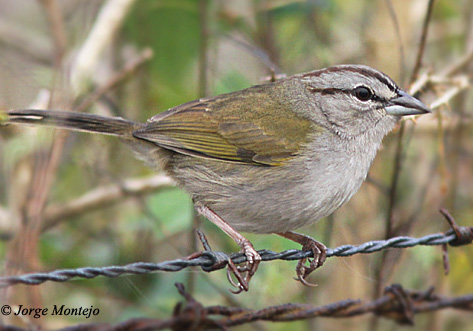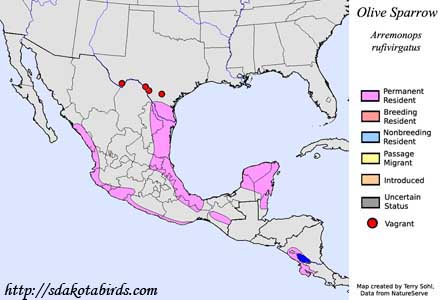| Length: 6.5 inches | Wingspan: 9 inches | Seasonality: Non-resident in South Dakota |
| ID Keys: Olive back, brown eye streak, brown-striped crown | ||
 The
Olive Sparrow is easily identified by its olive-colored back (the only
sparrow in North America with such a plumage feature), prominent stripe
through its eye, and brown stripes on its crown. It is mostly a bird
of Mexico, with scattered populations in Nicaragua, Guatemala, Costa Rica,
and Belize. It is also found in the U.S. in southern Texas. They
can be a difficult bird to see, given their preference for remaining close
to the ground in thick cover. They are frequently heard however, with
a distinctive song of accelerating series of chip notes.
The
Olive Sparrow is easily identified by its olive-colored back (the only
sparrow in North America with such a plumage feature), prominent stripe
through its eye, and brown stripes on its crown. It is mostly a bird
of Mexico, with scattered populations in Nicaragua, Guatemala, Costa Rica,
and Belize. It is also found in the U.S. in southern Texas. They
can be a difficult bird to see, given their preference for remaining close
to the ground in thick cover. They are frequently heard however, with
a distinctive song of accelerating series of chip notes.
Habitat: Found in open woodlands, often arid woodland but also more moist deciduous woodlands, although they avoid humid tropical forest. They prefer the thickets and brush of the forest undergrowth, as well as brushy forest edges and clearings. Also found in nonforest areas in scrubby thickets, such as areas of thorn scrub.
Diet: Feeds on both vegetative and animal matter, with seeds comprising a large portion of the diet. Insects and other small invertebrates are also consumed at all seasons, particularly during the breeding season.
Behavior: Forages on or close to the ground, moving through low vegetation or walking along the ground in search of food. They will often use their feet to scratch at the ground or in leaf litter, in a similar manner to many towhees.
Nesting: The nest of an Olive Sparrow is a cup placed in a bush or cactus, relatively close to the ground. It is cup with a domed top, made of grasses, leaves, bark, and other vegetative bits, lined with softer material such as hair or feathers. The female lays between 2 and 5 eggs, and she alone incubates them. Both parents help to feed the young. They will generally raise 2 broods each season.
Song: Song is a long series of chip notes that accelerate throughout.
Migration: Considered non-migratory throughout its range. They don't stray widely from their core range, and vagrants outside of that range are rare.
Feeders: Will attend feeder for sunflower seeds and other commonly offered seed items.
Interactive eBird map: Click here to access an interactive eBird map of Olive Sparrow sightings
Similar Species: Distinctive olive back separates it most other sparrow species. Could potentially be confused with Green-tailed Towhee.
Conservation Status: There are indications that populations of the Olive Sparrow are increasing. They are also found across a wide geographic range. The IUCN lists the Olive Sparrow as a species of "Least Concern".
Further Information: 1) Audubon Guide - Olive Sparrow
2) Texas Breeding Bird Atlas - Olive Sparrow
3) WhatBird - Olive Sparrow
Photo Information: Photo by Jorge Montejo - Yucatan of Mexico - Photo licensed under Creative Commons Attribution NonCommercial NoDerivs 2.0 Generic License
| Click below for a higher-resolution map |
 |
| South Dakota Status: Non-resident in South Dakota |
Additional Olive Sparrow Photos (coming soon!!)
